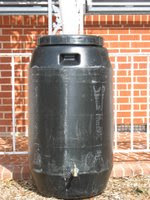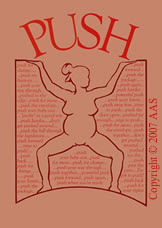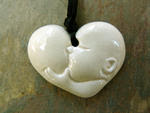Self-Attachment in the First Hour of Life: A Biologically Programmed Process and
The Foundation for a Happy Life
The Foundation for a Happy Life
by Janel Martin-Miranda, excerpts from www.ItstheBabysBirth.com

When baby and mom are unmedicated during labor and birth, and when left in the arms of his mother to rest, to gaze into her eyes, and to smell her and feel her loving touch, he will begin to crawl to her breast when his biological impulse guides him. With only his mother's touch and support, he will smell her nipple, lick at it, and attach himself to her breast. This process completes a significant sequence in the baby's nervous system.
Baby here was born at home and did self-attachment process. Babies born at ho
 me almost always experience some degree of this and this might be why babies born at home have such a high rate of success in breastfeeding compared to babies born in hospitals. Babies born in the hospital setting rarely are left in their mother’s arms because unnecessary cleaning, weighing, and shots and eye ointments that are known to interfere with bonding are done first. Mothers, under the influence of drugs may be not be as receptive.
me almost always experience some degree of this and this might be why babies born at home have such a high rate of success in breastfeeding compared to babies born in hospitals. Babies born in the hospital setting rarely are left in their mother’s arms because unnecessary cleaning, weighing, and shots and eye ointments that are known to interfere with bonding are done first. Mothers, under the influence of drugs may be not be as receptive.
Regardless of where birth occurs the baby should be left with the mother or the father for all interventions, and while mother is being cared for.
Physiologically, this Self-Attachment process is the ccompletion of a biologically programmed process that begins with the baby's initiation of labor (via his hormonal signal to the mother.) Scientists know that the human baby has a biological impulse to begin his or her labor and birth, and that this process completes with the baby attaching to the mother's breast. This process of labor, birth, and meeting and reconnecting after separation from the womb will forever define the mother-child relationship; negatively, unless we consciously repair it.
Following are pictures of two births where I supported the baby and mother do the self-attachment process.First, is a cesarean birth and next a VBAC. Father is holding son skin-to-skin after cesarean birth and while waiting for mother to be able to hold baby. Notice the bliss on the mother's faces.
Self-Attachment is supported by the last decade of brain development and the ground breaking
 research by Lennart Righard, MD, a pediatrician and researcher in the field of birth and breast-feeding (The Lancer, 1990. Volume 336; pages 1105-07), and by the work of pioneers in the Pre and Perinatal Psychology field.
research by Lennart Righard, MD, a pediatrician and researcher in the field of birth and breast-feeding (The Lancer, 1990. Volume 336; pages 1105-07), and by the work of pioneers in the Pre and Perinatal Psychology field.Dr. Lennert published a study in 1990 “that looked at two groups of newborns. In the first group the infant was placed on the mother’s abdomen and within fifty minutes most infants and self attached to the breast and were suckling correctly. In the second group the newborn babies were removed from the mother’s abdomen, bathed, measured, and replaced on the abdomen. The infants in this group from an unmedicated birth self-attached but half of them had a faulty suckling patter
 n. Most of the infants from a medicated birth were too drowsy to be able to suckle at all.” (From the cover description of the video, “Delivery Self-Attachment”, produced by Lennert). Purchase video at: http://www.geddesproduction.com/self.html
n. Most of the infants from a medicated birth were too drowsy to be able to suckle at all.” (From the cover description of the video, “Delivery Self-Attachment”, produced by Lennert). Purchase video at: http://www.geddesproduction.com/self.htmlDidn't get to this with your baby? Not to worry. Jack Newman, MD, Canadian breastfeeding guru and author of, encourages the process of self-attachment within the first six weeks to assist babies in latching and breastfeeding. The six-week window for completing the self-attachment reflex corresponds with the Baurer's and Stepping reflexes of the newborn. Infant Self-Attachment by Teresa Pitman, colleague of Dr. Newman and co-author of, The Ultimate Breastfeeding Book of Answers. Read the article at www.lalecheleague.org/llleaderweb/LV/LVDecJan03p123.html.

Your baby is past six-weeks? Still not to worry. Self-attachment is a central part of the birth trauma healing. Ninety-nine percent of humans are not allowed to do this important process. The good news is that it can be experienced even in medicalized and drugged births and at any age. The earlier the better, of course.
In twenty-five years of work with infants, children, and adults, my teacher, Dr. Raymond Castellino (www.beba.org) has discovered that the Self-Attachment process of reconnecting outside the womb is a crucial event that must happen in order for optimal ability of a human being to attach to his or her parents and for the parents to bond with the newborn. He has found this to be a basic biological need of the human being. The critical break leads to a multitude of human issues seen in our culture. In his model of prenatal and birth healing, he has discovered that the biological impulse and need for the self-attachment is a universal and a biologically, physiological impulse. When one does the birth trauma healing the impulse is for the human to spontaneously pursue self-attachment.
Following are pictures of me supporting my grandson and daughter to do the self-attachment process exactly after one hour of interventions and observa
 tions. It is never too late for mother and baby to connect.
tions. It is never too late for mother and baby to connect. 

The last pictures are comparing my daughter's two son's births. The first one shows her bliss (one might even say she was ecstatic if one had been there to hear and see her) after the self-attachment with her second son. The other shows her and first son post-operative hours later, both drugged and exhausted after he was born by Cesareann surgery.
s harmed. Post-partum depression is the woman's psyche try
 ing to bring up the emotions for resolutions. There are few resources for truly processing this wounding. Traditional talk therapy is inadequate and psychologists and counselors are not trained to recognize the deep violations and manifestations of traumatic birth experiences. Traditional "Human Development" courses begin in childhood, and maybe infancy now. That is the "bad news" -- a whole lot of it.
ing to bring up the emotions for resolutions. There are few resources for truly processing this wounding. Traditional talk therapy is inadequate and psychologists and counselors are not trained to recognize the deep violations and manifestations of traumatic birth experiences. Traditional "Human Development" courses begin in childhood, and maybe infancy now. That is the "bad news" -- a whole lot of it.The "good news" is that forty years work of prenatal and birth trauma healing pioneers, Emerson, McCarty, and Castellino now show us that this critical need in the central nervous system for self-attachment can happen at any age. And, with their pioneering work with babies and adults, we know now that resolved trauma from labor and birth babies will instinctually do the self-attachment process as will children and adults. (By the way, many women are led by their inner knowing to seek out the natural, vaginal birth in order to heal their own psyche.)
In twenty-five years of work with infants, children, and adults, my
 teacher, Dr. Raymond Castellino (www.beba.org) has discovered that the Self-Attachment process of reconnecting outside the womb is a crucial event that must happen in order for optimal ability of a human being to attach to his or her parents and for the parents to bond with the newborn. He has found this to be a basic biological need of the human being. The critical break leads to a multitude of human issues seen in our culture.
teacher, Dr. Raymond Castellino (www.beba.org) has discovered that the Self-Attachment process of reconnecting outside the womb is a crucial event that must happen in order for optimal ability of a human being to attach to his or her parents and for the parents to bond with the newborn. He has found this to be a basic biological need of the human being. The critical break leads to a multitude of human issues seen in our culture.In Dr. Castellino's model of prenatal and birth healing, he has discovered that the biological impulse and need for the self-attachment is a universal and a biologically, physiological impulse. When one does the birth trauma healing the impulse is for the human to spontaneously pursue self-attachment.
Medical caregivers have the power to make the biggest difference imaginable if they would merely see the needs of the birthing baby and mother to have quiet, no strangers touching, and no medically unnecessary interventions in first two hours of life, and whatever is done is done in the arms of the mother or the father. THIS could change the world.








5 comments:
Nice pages here. Great information. Will visit again and recommend.
...O.o are you commenting just to advertise your blog?
Wow... very profound. However I'd like to know more about self attachment if a baby is older than six weeks. I'm a mom of five home born babies and none was allowed to self attach although all were breastfed.
My new baby had a traumatic birth (for me) but an intuitive, sensitive midwife who did not interfere. I don't know if she was malpositioned or what.
At any rate, I'm interested in learning about self attachment in babies older than 6 weeks.
Thanks. You can check out my site and the self-attachment page here http://www.itsthebabysbirth.com/parentsknow/attach.htm
I'll be adding more info about healing of birth trauma.
Thanks for the post.
Medical Videos help to educate all on various health issues, their causes and effects.
Post a Comment